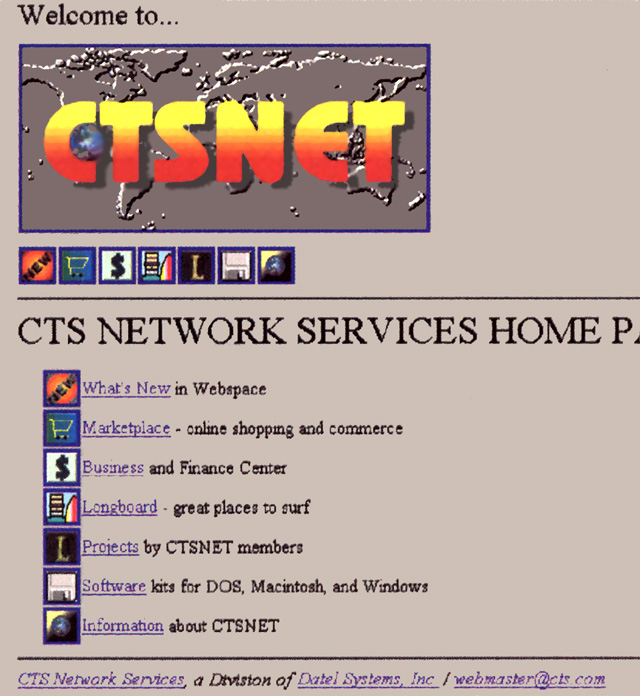How Far We’ve Come in 18 Years
A Look Back at the World Wide Web
This is a partial screenshot of one of the first web pages I ever created for CTSnet, a San Diego-based Internet service provider. It was scanned from a page published in Success Magazine in 1994.
This wasn’t my first web page, though. I started learning HTML in 1993 for a browser called Lynx, then cutting edge web technology. It was text-only. You navigated by keyboard. That same year, the NCSA Mosaic browser came out sporting images, colors, and mouse navigation. The Mosaic browser is considered to be the precursor to the Internet boom.
Hard to believe it was nearly two decades ago that I first had my hands in the web. It’s cliché to say, but looking back on this image and recalling what it took back then to produce the graphics and HTML … it seems like only yesterday. Some things haven’t changed much.
For one, I (and most decent web designers) still tend to build sites with two key tools: a graphics program like Photoshop and a text editor. That’s still all you need to create amazing web sites. A few tools promised to revolutionize the way we build HTML pages, like Microsoft’s FrontPage and Adobe’s Dreamweaver which are now passé. But unlike indispensable desktop publishing tools such as PageMaker, QuarkXpress, and InDesign, the web has escaped the need for such a tool. Some of us even prefer it that way.
Though we’ve come a very long way, the web’s darker moments remind me of what a struggle it has often been.
Dark Days in Web History
I lived and worked through this stuff.
I remember the GIF image controversy in 1994 that threatened to take away the one key feature of the new World Wide Web that attracted millions to the Internet: graphics. It spurred the development of the PNG format.
I remember the day in 1996 when the whole web went black as a form of voter protest against the unconstitutional Communications Decency Act. This was before the advent of style sheets. So every page tediously had to have its background color set to black, and all the font colors had to be changed so pages were still readable. Two days later, undo.
I remember the day in 2006 when much of the web stopped working like it did the day before. The infamous $521M Eolas patent lawsuit against Microsoft caused the makers of Internet Explorer to release an automatic update that affected the appearance and functionality of Flash and other ActiveX controls to work in web pages. It was ridiculous. Equally ridiculous and sad, there are web design companies that still rely heavily on Flash, and unwitting clients who continue to pay for it.
I remember (and would like to forget) the single biggest hindrance to the evolution of the web: Internet Explorer, notably version 6, or notoriously known as IE6, released in 2001. For a decade now — which is over half the age of the world wide web — Microsoft held back advances in web technology and delayed the adoption of features that we should have been enjoying five years ago. In fact, the utter failure of Microsoft to produce a better operating system than Windows XP has caused many to remain anchored to the extremely buggy, non-compliant, security-weak IE6 even today. The flop of its much vaunted Vista operating system left many leery of jumping to Windows 7, far superior to any previous Microsoft OS. After years of fighting, cursing at, and generally stressing out over Internet Explorer, web designers have basically had enough and are becoming indifferent to its Luddite adherents. Time to move on, folks. Even Microsoft is attempting to light a fuse in hopes of hastening IE6’s demise. We can only hope IE9 will improve, but I’m not holding my breath.
Brighter Days Ahead
But here’s the thing. Within the last year, we’ve seen some amazing advances in web technology. Perhaps it was Mozilla Corporation’s recent release of Firefox 4, and the simultaneous announcement on the same day from Google regarding nifty features in it’s Chrome 11 browser (still in beta) that has me feeling optimistic about the future of the web. I’m excited about leaving the old web behind and finally feeling liberated to move forward.
If nothing else, the one thing I take away from these past couple of decades is that the Internet will evolve despite the intentional or unintentional foibles by any single corporation, lawyers, the lawsuits engaged in by both, politicians, and oppressive countries that attempt to censor content. Just like the Internet routing protocol itself, we will just “route around” the damage and keep the packets flowing.
What a cool time to be a web designer.
Add a Comment

